springCloud框架
Spring Cloud简介
Spring Cloud 是在Spring Boot 的基础上构建的,用于简化分布式系统构建的工具集。该工具集为微服务架构中所涉及的配置管理、服务发现、智能路由、断路器、微代理和控制总线等操作提供了一种简单的开发方式。
Spring Cloud的特点
Spring Cloud有很多特点,其中最大的特点就是它的集成性,它将很多开源产品都集成到了自身的框架中,使其越来越强大。
除此之外,Spring Cloud还有如下特点。
1.使用方便
在使用时,开发人员不需要过多的配置,也不需要调用很多接口,通过简单的配置即可轻松上手。
2.功能齐全
Spring Cloud涵盖了微服务架构中的各个方面,集成了很多公司优秀的开源框架,能够充分满足微服务开发者的各项需求。
3.易于扩展和维打
所有组件的引入方式相同,都是通过 Maven或Gradle引入依赖。各个组件之间没有代码上的耦合,因此可以根据需求不断地增加、删除和替换组件。
4.适用于各种环境
使用 Spring Cloud 组件开发的项目可以应用于 PC 服务器、云环境,以及各种容器(如Docker )。
1. Eureka
Eureka 是Netlix开发的一个服务发现框架,本身是一个基于REST的服务,主要用于定位运行在 AWS(Amazon Web Services)域中的中间层服务,以达到负载均衡和中间层服务故障 转移的目的。Spring Cloud将其集成在自己的子项目 Spring Cloud Netlix中,以实现 Spring| Cloud 的服务发现功能。
Eureka 的服务发现包含两大组件:服务端发现组件(Eureka Server)和客户端发现组件(Eureka Client )。服务端发现组件也被称之为服务注册中心,主要提供了服务的注册功能,而客户端发现组件主要用于处理服务的注册与发现。
使用Eureka 注册服务
1.搭建Maven父工程
<project xmlns="http://maven.apache.org/POM/4.0.0" xmlns:xsi="http://www.w3.org/2001/XMLSchema-instance" xsi:schemaLocation="http://maven.apache.org/POM/4.0.0 http://maven.apache.org/xsd/maven-4.0.0.xsd"> <modelVersion>4.0.0</modelVersion> <groupId>com.itheima</groupId> <artifactId>microservice-springcloud</artifactId> <version>0.0.1-SNAPSHOT</version> <packaging>pom</packaging> <parent> <groupId>org.springframework.boot</groupId> <artifactId>spring-boot-starter-parent</artifactId> <version>1.5.6.RELEASE</version> <relativePath/> </parent> <properties> <project.build.sourceEncoding> UTF-8 </project.build.sourceEncoding> <project.reporting.outputEncoding> UTF-8 </project.reporting.outputEncoding> <java.version>1.8</java.version> </properties> <dependencyManagement> <dependencies> <dependency> <groupId>org.springframework.cloud</groupId> <artifactId>spring-cloud-dependencies</artifactId> <version>Dalston.SR3</version> <type>pom</type> <scope>import</scope> </dependency> </dependencies> </dependencyManagement> <dependencies> <!-- <dependency> --> <!-- <groupId>org.springframework.cloud</groupId> --> <!-- <artifactId>spring-cloud-starter-config</artifactId> --> <!-- </dependency> --> <!-- <dependency> --> <!-- <groupId>org.springframework.boot</groupId> --> <!-- <artifactId>spring-boot-devtools</artifactId> --> <!-- </dependency> --> </dependencies> <build> <plugins> <!--Spring Boot的编译插件 --> <plugin> <groupId>org.springframework.boot</groupId> <artifactId>spring-boot-maven-plugin</artifactId> </plugin> </plugins> </build> </project>
2.搭建服务端工程
(1)添加依赖。在 pom.xml中添加Eureka Server的依赖
<project xmlns="http://maven.apache.org/POM/4.0.0" xmlns:xsi="http://www.w3.org/2001/XMLSchema-instance" xsi:schemaLocation="http://maven.apache.org/POM/4.0.0 http://maven.apache.org/xsd/maven-4.0.0.xsd"> <modelVersion>4.0.0</modelVersion> <parent> <groupId>com.itheima</groupId> <artifactId>microservice-springcloud</artifactId> <version>0.0.1-SNAPSHOT</version> </parent> <artifactId>microservice-eureka-server</artifactId> <dependencies> <dependency> <groupId>org.springframework.cloud</groupId> <artifactId>spring-cloud-starter-eureka-server</artifactId> </dependency> </dependencies> </project>
(2)编写配置文件。在配置文件application.yml中增加端口号等配置信息
server:
port: 8761
eureka:
instance:
hostname: localhost
client:
register-with-eureka: false
fetch-registry: false
service-url:
defaultZone: http://${eureka.instance.hostname}:${server.port}/eureka/
# server:
# enable-self-preservation: false
(3)修改服务端 Java代码。在项目的引导类上添加注解@EnableEurekaServer,该注解用声明标注类是一个Eureka Server
@EnableEurekaServer @SpringBootApplication public class MicroserviceEurekaServerApplication { public static void main(String[] args) { SpringApplication.run(MicroserviceEurekaServerApplication.class, args); } }
(4)启动应用,查看信息。完成上述配置后,启动应用程序并在浏览器中访问地士http://localhost:8761/
3.搭建客户端工程
1)添加依赖
<project xmlns="http://maven.apache.org/POM/4.0.0" xmlns:xsi="http://www.w3.org/2001/XMLSchema-instance" xsi:schemaLocation="http://maven.apache.org/POM/4.0.0 http://maven.apache.org/xsd/maven-4.0.0.xsd"> <modelVersion>4.0.0</modelVersion> <parent> <groupId>com.itheima</groupId> <artifactId>microservice-springcloud</artifactId> <version>0.0.1-SNAPSHOT</version> </parent> <artifactId>microservice-config-client</artifactId> <dependencies> <dependency>
<groupId>org.springframework.cloud</groupId>
<artifactId>spring-cloud-starter-eureka</artifactId>
</dependency> </dependencies> </project>
(2)编写配置文件
server:
port: 8000 #指定该Eureka实例的端口号
eureka:
instance:
prefer-ip-address: true #显示主机IP地址
client:
service-url:
defaultZone: http://localhost:8761/eureka/ # 指定 Eureka服务端地址
application:
name: microservice-eureka-user #指定应用名称
(3)修改客户端 Java 代码 。在项目的引导类上添加注解@EnableEurekaClient,该注解. 明标注类是一个 Eureka 客户端组件
3.搭建订单服务
(1)在 pom.xml中添加 spring-cloud-starter-eureka 依赖
<project xmlns="http://maven.apache.org/POM/4.0.0" xmlns:xsi="http://www.w3.org/2001/XMLSchema-instance" xsi:schemaLocation="http://maven.apache.org/POM/4.0.0 http://maven.apache.org/xsd/maven-4.0.0.xsd"> <modelVersion>4.0.0</modelVersion> <parent> <groupId>com.itheima</groupId> <artifactId>microservice-springcloud</artifactId> <version>0.0.1-SNAPSHOT</version> </parent> <artifactId>microservice-eureka-order</artifactId> <dependencies> <dependency> <groupId>org.springframework.cloud</groupId> <artifactId>spring-cloud-starter-eureka</artifactId> </dependency> </dependencies> </project>
(2)编写配置文件。在配置文件中添加 Eureka服务实例的端口号、服务端地址等信息
server:
port: 7901 # 指定该Eureka实例的端口号
eureka:
instance:
prefer-ip-address: true # 是否显示主机的IP
client:
service-url:
defaultZone: http://localhost:8761/eureka/ # 指定Eureka服务端地址
spring:
application:
name: microservice-eureka-order # 指定应用名称
(3)在引导类中加入@EnableEurekaClient
(4)在microservice-eureka-user 工程的引导类中,创建 RestTemplate
RestTemplate是 Spring提供的用于访问 Rest服务的客户端实例,它提任了多种便捷访问远程Http服务的方法,能够大大提高客户端的编写效率。
@SpringBootApplication @EnableEurekaClient @RestController public class Application { @RequestMapping("/hello") public String home() { return "hello world!"; } /** * 实例化RestTemplate * RestTemplate是Spring提供的用于访问Rest服务的客户端, * 它提供了多种便捷访问远程Http服务的方法,能够大大提高客户端的编写效率。 */ @Bean public RestTemplate restTemplate() { return new RestTemplate(); } public static void main(String[] args) { SpringApplication.run(Application.class, args); } }
@RestController public class UserController { @Autowired private RestTemplate restTemplate; /** * 查找与用户相关的订单 */ @GetMapping("/findOrderByUser/{id}") public String findOrderByUser(@PathVariable String id) { int oid = 123; return this.restTemplate.getForObject("http://microservice-eureka-order/order/" + id, String.class); } }
在上述代码中,当用户查询订单时,首先会通过用户id 查询与用户相关的所有订单(由于这里主要是演示服务的调用,所以省略了查询方法,并且自定义了一个oid为123的订单,来模拟查询出的结果)。然后通过 restTemplate 对象的getForObject()方法调用了订单服务中的查询订单方法来查询订单id为123的订单信息。
客户端负载均衡
在分布式架构中,服务器端负载均衡通常是由Nginx 实现分发请求的,而客户端的同一个实例部署在多个应用上时,也需要实现负载均衡。通过 Spring Cloud中的 Ribbon 来实现此功能。
Ribbon 介绍
Ribbon是Netlix发布的开源项目,其主要功能是提供客户端的软件负载均衡算法,将Netlix的中间层服务连接在一起。Ribbon 的客户端组件提供了一系列完善的配置项,例如连接超时、重试等。 在 Eureka的自动配置依赖模块 spring-cloud-starter-eureka中,已经集成了Ribbon,我们可以直接使用 Ribbon来实现客户端的负载均衡。 二者同时使用时,Ribbon 会利用从 Eureka 读取到的服务信息列表,在调用服务实例时,以合理的方式进行负载。
Ribbon的使用
在 Eureka 中使用 Ribbon 十分简单,只需要在实例化 RestTemplate 的方法上添加@LoadBalanced 注解,并在其执行方法中使用服务实例的名称即可。
具体实现过程如下:
(1)添加@LoadBalanced 注解。在 microservice-eureka-user 工程引导类中的restTemplate()方法上添加@LoadBalanced 注解,
@SpringBootApplication @EnableEurekaClient @RestController public class MicroserviceEurekaUserApplication { @RequestMapping("hello") public String hello() { return "欢迎光临"; } public static void main(String[] args) { SpringApplication.run(MicroserviceEurekaUserApplication.class, args); } /*访问Rest服务的客户实例 * RestTemplate是spring提供的用于访问rest服务的客户端 * 提供了便捷访问远程Http服务方法,提高效率 * */ @Bean @LoadBalanced public RestTemplate restTemplate() { return new RestTemplate(); } }
@RestController public class UserController { @Autowired private RestTemplate restTemplate; /** * 查找与用户相关的订单 */ @GetMapping("/findOrderByUser/{id}") public String findOrderByUser(@PathVariable String id) { int oid = 123; /*加入负载均和localhost:7900/order可以改成microservice-eureka-order*/ return this.restTemplate.getForObject("http://microservice-eureka-order/order/" + id, String.class); } }
(2)创建服务监听类ServiceInfoUtil.java
在microservice-eureka-order工程中创建一个用于监听服务实例端口的工具类 ServicelnfoUtil。
@Configuration public class ServiceInfoUtil implements ApplicationListener<EmbeddedServletContainerInitializedEvent> { /*声明event对象,EmbeddedServletContainerInitializedEvent 用于获取运行服务器的本地端口 * */ private static EmbeddedServletContainerInitializedEvent event; @Override public void onApplicationEvent(EmbeddedServletContainerInitializedEvent event) { ServiceInfoUtil.event = event; } /*获得端口号*/ public static int getPort() { return event.getEmbeddedServletContainer().getPort(); } }
(3)添加输出语句。在订单控制器类 OrderController的查询订单方法中,增加一行执行输出当前实例端口号的语句。具体如下: System.out.println(ServiceInfoUtil.getPort());
Spring Cloud Hystrix
在微服务架构中,通常会存在多个服务层调用的情况,如果基础服务出现故障可能会发生级联传递,导致整个服务链上的服务不可用pring Cloud Hystrix就是用来实现断路器、线程隔离等服务保护功能的。Spring Cloud Hystrix是基于Netlix的开源框架 Hystrix 实现的,该框架的使用目标在于通过控制那些访问远程系统、服务和第三方库的节点,从而对延迟和故障提供更强大的容错能力。
(1)创建microservice-eureka-user-hystrix工程添加依赖
<project xmlns="http://maven.apache.org/POM/4.0.0" xmlns:xsi="http://www.w3.org/2001/XMLSchema-instance" xsi:schemaLocation="http://maven.apache.org/POM/4.0.0 http://maven.apache.org/xsd/maven-4.0.0.xsd"> <modelVersion>4.0.0</modelVersion> <parent> <groupId>com.itheima</groupId> <artifactId>microservice-springcloud</artifactId> <version>0.0.1-SNAPSHOT</version> </parent> <artifactId>microservice-eureka-user-hystrix</artifactId> <dependencies> <dependency> <groupId>org.springframework.cloud</groupId> <artifactId>spring-cloud-starter-eureka</artifactId> </dependency> <!-- Hystrix依赖 --> <dependency> <groupId>org.springframework.cloud</groupId> <artifactId>spring-cloud-starter-hystrix</artifactId> </dependency> <dependency> <groupId>org.springframework.boot</groupId> <artifactId>spring-boot-starter-actuator</artifactId> </dependency> <dependency> <groupId>com.netflix.hystrix</groupId> <artifactId>hystrix-core</artifactId> <version>1.5.12</version> </dependency> </dependencies> </project>
(2)配置文件
server:
port: 8030 # 指定该Eureka实例的端口号
eureka:
instance:
prefer-ip-address: true # 是否显示主机的IP
client:
service-url:
defaultZone: http://localhost:8761/eureka/ # 指定Eureka服务端地址
spring:
application:
name: microservice-eureka-user-hystrix # 指定应用名称
(3)在启动类上加入@EnableCircuitBreaker开启熔断机制
@SpringBootApplication @EnableEurekaClient @EnableCircuitBreaker public class MicroserviceEurekaUserHystrixApplication { /*访问Rest服务的客户实例 * RestTemplate是spring提供的用于访问rest服务的客户端 * 提供了便捷访问远程Http服务方法,提高效率 * */ @Bean @LoadBalanced public RestTemplate restTemplate() { return new RestTemplate(); } public static void main(String[] args) { SpringApplication.run(MicroserviceEurekaUserHystrixApplication.class, args); } }
(4)修改用户控制器类。在findOrdersByUser()方法上添加@HystrixCommand注解来指回调方法
@RestController public class UserController { @Autowired private RestTemplate restTemplate; /** * 查找与用户相关的订单 */ @GetMapping("/findOrderByUser/{id}") @HystrixCommand(fallbackMethod = "fallbackInfo") public String findOrderByUser(@PathVariable String id) { /*加入负载均和localhost:7900/order可以改成microservice-eureka-order*/ return this.restTemplate.getForObject("http://microservice-eureka-order/order/" + id, String.class); } /*返回信息*/ public String fallbackInfo(@PathVariable String id) { return "服务器不可用,请稍后再试!"; } }
@HystrixCommand 注解用于指定当前方法发生异常时调用的方法,该方法是通过其属性 fallbackMethod 的属性值来指定的。这里需要注意的是,回调方法的参数类型以及返回值必须要和原方法保持一致。
Hystrix Dashboard 的使用
Hystrix 除了可以对不可用的服务进行断路隔离外,还能够对服务进行实时监控。Hystrix 可以实时、累加地记录所有关于 HystrixCommand 的执行信息,包括每秒执行多少、请求成功多少、失败多少等。
1.加入实时监控的依赖
<dependency> <groupId>org.springframework.boot</groupId> <artifactId>spring-boot-starter-actuator</artifactId> </dependency>
在 microservice-eureka-user-hystrix 工程的 pom.xml中引入上述依赖后,即可查看监控信息,具体操作步骤如下。
(1)分别启动注册中心、服务提供者(7901)和服务消费者工程。
(2)通过浏览器访问地址 http://ocalhost:8030/findOrdersByUser/1(此步骤不可省略,否则将由于系统应用的所有接口都未被调用,而只输出 ping:)。
(3)通过浏览器访问地址 http://localhost:8030/hystrix.stream,将看到如图5-7所示的输出 信息。
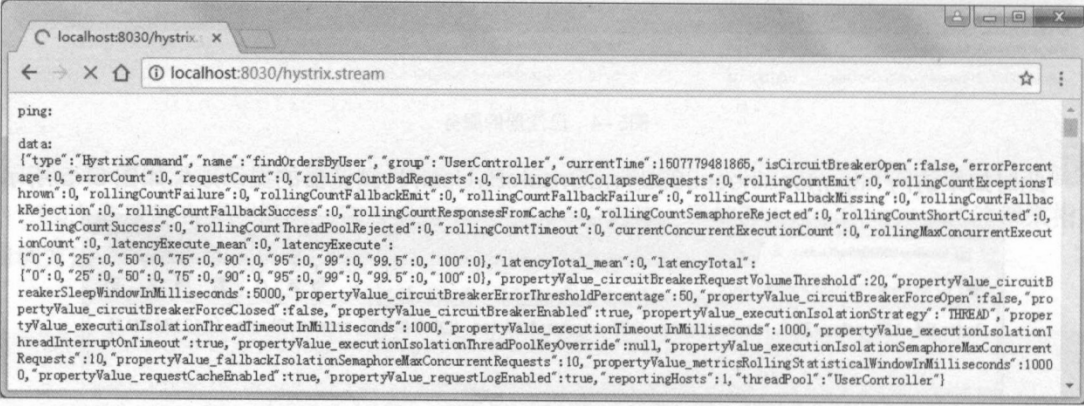
访问具体地址后,浏览器会不断地执行刷新操作以获取实时的监控数据。这样运维人员就可以通过这些数据来判断出系统当前的监控状态。 虽然采用上面这种纯文字输出的方式可以实时监控数据,但其可读性十分差。为此,我们可以通过 Hystrix Dashboard 以可视化的方式来查看实时监控数据。Hystrix Dashboard是Hystrix的一个组件,它提供了数据监控和友好的图形化界面支持。
(1)新建 microservice-springcloud 的子工程 microservice-hystrix-dashboard,在pom.xml文件中添加监控依赖和Hystrix Dashboard 依赖
<project xmlns="http://maven.apache.org/POM/4.0.0" xmlns:xsi="http://www.w3.org/2001/XMLSchema-instance" xsi:schemaLocation="http://maven.apache.org/POM/4.0.0 http://maven.apache.org/xsd/maven-4.0.0.xsd"> <modelVersion>4.0.0</modelVersion> <parent> <groupId>com.itheima</groupId> <artifactId>microservice-springcloud</artifactId> <version>0.0.1-SNAPSHOT</version> </parent> <artifactId>microservice-hystrix-dashboard</artifactId> <properties> <project.build.sourceEncoding> UTF-8 </project.build.sourceEncoding> <project.reporting.outputEncoding> UTF-8 </project.reporting.outputEncoding> <java.version>1.8</java.version> </properties> <dependencies> <dependency> <groupId>org.springframework.cloud</groupId> <artifactId> spring-cloud-starter-hystrix-dashboard </artifactId> </dependency> <dependency> <groupId>org.springframework.boot</groupId> <artifactId>spring-boot-starter-actuator</artifactId> </dependency> </dependencies> </project>
(2)编写配置文件 application.yml,指定应用的端口号和名称等信息
server:
port: 8031 # 指定该Eureka实例的端口号
spring:
application:
name: microservice-hystrix-dashboard # 指定应用名称
(3)编写启动类 Application.java,并在其类上添加@EnableHystrixDashboard 注解来开启Hystrix 仪表板功能
@SpringBootApplication //开启Hystrix仪表板功能 @EnableHystrixDashboard public class MicroserviceHystrixDashboardApplication { public static void main(String[] args) { SpringApplication.run(MicroserviceHystrixDashboardApplication.class, args); } }
(4)启动工程后,通过浏览器访问地址 http:/localhost:8031/hystrix.stream 将会看到如图5-8所示的信息. 在图5-8中,Hystrix Dashboard下的输入框用于输入需要监控的服务 URL,Delay 中的参数表示服务器上的轮询时间间隔,Title中的输入框用于设置浏览器中所监视服务的标题。 在Hystrix Dashboard 下的输入框中输入 http://ocalhost:8030/hystrix.stream,并设置 Title为"订单微服务"后,单击【Monitor Stream】按钮,将出现如图5-9所示页面。

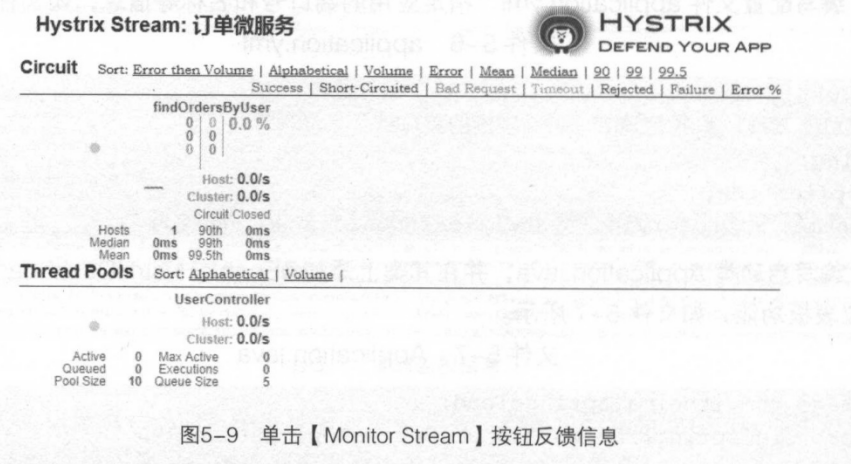

在Hystrix Dashboard Wiki上已经给出了详细说明,可访问地址 https:/github.com/Netlix/Hystrixwiki/Dashboard 查看
API 网关服务
使用Spring Boot 实现微服务的开发,使用 Spring Cloud Eureka实现注册中心以及服务的注册与发现,使用Spring Cloud Ribbon 实现服务间的负载均衡,使用 Spring Cloud Hystrix 实现线程的 隔离和断路器功能。

在图5-11中,集群包含了Service A和 Service B两种服务,它们会向 Eureka Server注册和订阅服务,Open Service是一个对外的 RESTul API服务,客户端会通过负载均衡技术(如Nginx)实现对Open Service的调用,同时服务之间也会通过Ribbon技术实现服务之间负载均衡的调用。 虽然通过这种方式实现系统功能是没有问题的,但在实际使用时,客户端与微服务进行直接的交互还是存在着一些困难和限制的,具体表现如下。
1.增加开发和维护成本
在大多数情况下,为了保证对外服务的安全性,开发人员在服务端实现的服务接口会有一定的权限校验机制(如用户登录状态校验等),并且为了防止客户端在发起请求时被篡改等安全方面的考虑,还会编写一些签名校验功能。在微服务中,我们会将原来处于一个应用中的多个模块 拆分成多个应用服务,而这些拆分出来的应用服务接口也需要原来的校验逻辑,这就导致我们不得不在这些应用中全部实现这样的一套逻辑。随着微服务规模的不断扩大,这些校验逻辑的冗余将越来越多,一旦校验规则有了变化或者出了问题,我们将不得不去每一个应用中修改这些逻辑。
2.微服务重构困难
随着时间的推移,我们可能需要改变系统服务目前的拆分方案(如将两个服务合并或将一个服务拆分为多个),但如果客户端直接与微服务交互,那么这种重构就很难实施。
3.微服务协议限制
客户端直接请求的微服务可能使用的是与Web无关的协议。一个服务可能是用Thrift的RPC协议,而另一个服务可能是用 AMQP消息协议,两种协议都不是特别适合浏览器或防火墙,最好是内部使用。应用应该在防火墙外采用HTTP或者 WEB Socket 之类的协议。
通常来说,一个很好的解决办法就是采用 APIGateway(网关)的方式。API Gateway是一个服务器,也可以说是进入系统的唯一节点,它封装了内部系统的架构,并且提供了API给各个客户端。它还可以有其他功能,如授权、监控、负载均衡、缓存、请求分片和管理、静态响应处理等。

在图5-12中,APIGateway 负责请求转发、合成和协议转换。所有来自客户端的请求都要先经过 API Gateway,然后负载均衡这些请求到对应的微服务 APIGateway的一个最大好处是封装了应用的内部结构,与调用指定的服务相比,客户端直接跟 Gateway 交互会更简单。API Gateway 提供给每一个客户端一个特定 APl,这样减少了客户端与服务器端的通信次数,也简化了客户端代码。API Gateway还可以在Web协议与内部使用的非Web协议间进行转换,如HTTP协议、WebSocket协议。 API Gateway 可以有很多实现方法,如Nginx、Zuul、Node.js
4.使用Zuul 构建 API网关服务
Spring Cloud中。Zuul 属于边缘服务,可以用来执行认证、.动态路由、服务迁移、负载均衡。
(1)创建工程,添加依赖。在父工程 microservice-springcloud 下创建子模块 microservice-gateway-zuul工程,并在其 pom.xml中添加 eureka和Zuul 的依赖
<project xmlns="http://maven.apache.org/POM/4.0.0" xmlns:xsi="http://www.w3.org/2001/XMLSchema-instance" xsi:schemaLocation="http://maven.apache.org/POM/4.0.0 http://maven.apache.org/xsd/maven-4.0.0.xsd"> <modelVersion>4.0.0</modelVersion> <parent> <groupId>com.itheima</groupId> <artifactId>microservice-springcloud</artifactId> <version>0.0.1-SNAPSHOT</version> </parent> <artifactId>microservice-gateway-zuul</artifactId> <dependencies> <dependency> <groupId>org.springframework.cloud</groupId> <artifactId>spring-cloud-starter-zuul</artifactId> </dependency> <dependency> <groupId>org.springframework.cloud</groupId> <artifactId>spring-cloud-netflix-eureka-client</artifactId> <version>1.3.4.RELEASE</version> <scope>compile</scope> </dependency> <dependency> <groupId>org.springframework.cloud</groupId> <artifactId>spring-cloud-starter-eureka</artifactId> </dependency> </dependencies> </project>
(2)编辑配置文件。在配置文件中编写Eureka服务实例的端口号、服务端地址等信息
server:
#指定该Eureka实例的端口号
port: 8050
#eureka:
#instance:
#prefer-ip-address: true # 是否显示主机的IP
#client:
#service-url:
#defaultZone: http://localhost:8761/eureka/ # 指定Eureka服务端地址
spring:
application:
name: microservice-gateway-zuul # 指定应用名称
zuul:
routes:
#order-serviceId: # zuul的唯一标识,可以任意设置名称,但必须唯一,如果该值与service-id的名称相同时,service-id的值可以省略
# 需要映射的路径
#path: /order/**
# Eureka中的serviceId
#service-id: microservice-eureka-order
order-url:
path: /order-url/**
url: http://localhost:7900/
#ignored-services:

(3)在工程主类 Application中使用@EnableZuulProxy 注解开启Zuul的API 网关功能,
@EnableEurekaClient @EnableZuulProxy @SpringBootApplication public class MicroserviceGatewayZuulApplication { public static void main(String[] args) { SpringApplication.run(MicroserviceGatewayZuulApplication.class, args); } }
(4)分别启动注册中心、服务提供者和网关服务后,注册中心已注册的服务

Zuul 的单独使用 上面的示例中,我们是将 Spring CloudZuul与 Spring Cloud Eureka 整合在一起使用的,此种方式可以让路由映射到具体服务。除此之外,Zul还可以不依赖 Eureka而单独使用。
order-url为Zul 的唯一标识,可以任意设置名称,但必须唯一。Path属性用于设置需要映射的路径,而url的属性值为path路由到的地址。
分布式配置管理
在传统的单体式应用系统中,我们通常会将配置文件和代码放在一起,但随着系统越来越大,需要实现的功能越来越多时,我们又不得不将系统升级为分布式系统,同时也会将系统的功能进行更加细化的拆分。拆分后,所有的服务应用都会有自己的配置文件,当需要修改某个服务的配| 置时,我们可能需要修改很多处,并且为了某一项配置的修改,可能需要重启这个服务相关的所|有服务,这显然是非常麻烦的。 为了便于集中配置的统一管理,在分布式架构中通常会使用分布式配置中心组件,目前比较流行的分布式配置中心组件有百度的disconf、阿里的 diamond、携程的apollo和Spring Cloud 的Config等。相对于同类产品而言,Spring Cloud Config 最大的优势就是和Spring的无缝集成,对于已有的 Spring 应用程序的迁移成本非常低,结合Spring Boot 可使项目有更加统一的标准(包括依赖版本和约束规范),避免了因集成不同开发软件造成的版本依赖冲突等问题。
Spring Cloud Config是 Spring Cloud团队创建的一个全新的项目,该项目主要用来为分布式系统中的外部配置提供服务器(Config Server)和客户端(Contig Client)支持。
●服务器端(Config Server):也被称之为分布式配置中心,它是一个独立的微服务应用,主要用于集中管理应用程序各个环境下的配置,默认使用Git 存储配置文件内容,也可以使用SVN存储,或者是本地文件存储。
●客户端(Config Client):是Contig Server 的客户端,即微服务架构中的各个微服务应用。 它们通过指定的配置中心(Config Server)来管理应用资源以及与业务相关的配置内容,并在启|动时从配置中心获取和加载配置信息。
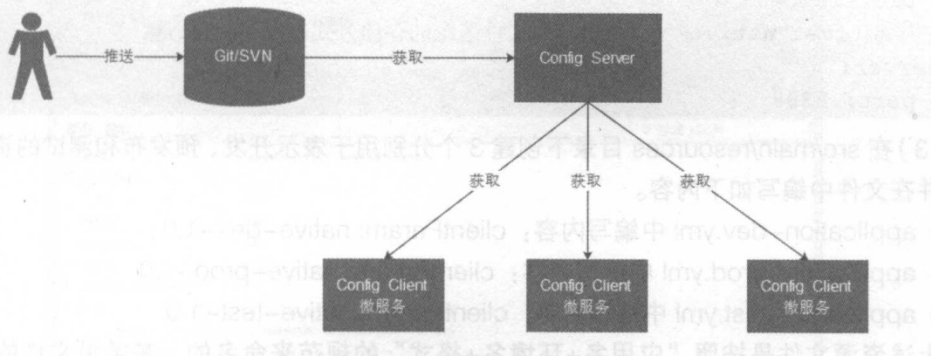
1.搭建 Config Server
(1)创建配置中心工程microservice-config-server,并在其 pom.xml中引入 Config Server的依赖
<project xmlns="http://maven.apache.org/POM/4.0.0" xmlns:xsi="http://www.w3.org/2001/XMLSchema-instance" xsi:schemaLocation="http://maven.apache.org/POM/4.0.0 http://maven.apache.org/xsd/maven-4.0.0.xsd"> <modelVersion>4.0.0</modelVersion> <parent> <groupId>com.itheima</groupId> <artifactId>microservice-springcloud</artifactId> <version>0.0.1-SNAPSHOT</version> </parent> <artifactId>microservice-config-server</artifactId> <dependencies> <dependency> <groupId>org.springframework.cloud</groupId> <artifactId>spring-cloud-config-server</artifactId> </dependency> </dependencies> </project>
(2)编写配置文件application.yml,添加服务端口号和存储属性等信息
spring:
application:
name: microservice-config-server
profiles:
active: native # 使用本地文件系统的存储方式来保存配置信息
server:
port: 8888
(3)创建3个分别用于表示开发、预发布和测试的资源配置文件
● application-dev.yml 中编写内容:clientParam:native-dev-1.0
clientParam: native-dev-1.0
●application-prod.yml 中编写内容:clientParam: native-prod-1.0
clientParam: native-prod-1.0
●application-test.yml中编写内容:clientParam: native-test-1.0
clientParam: native-test-1.0

(4)创建启动类,并在类上增加@EnableConfigServer注解以开启服务端功能
@EnableConfigServer @SpringBootApplication public class MicroserviceConfigServerApplication { public static void main(String[] args) { SpringApplication.run(MicroserviceConfigServerApplication.class, args); } }
(5)启动工程,测试应用。应用启动成功后,按照如下格式的URL发起请求:http://localhost:8888/(applicationname)/{env}/{label}

2.搭建 Config Client
(1)创建客户端工程microservice-config-client,并在其 pom.xml中添加 Config 和的依赖
<project xmlns="http://maven.apache.org/POM/4.0.0" xmlns:xsi="http://www.w3.org/2001/XMLSchema-instance" xsi:schemaLocation="http://maven.apache.org/POM/4.0.0 http://maven.apache.org/xsd/maven-4.0.0.xsd"> <modelVersion>4.0.0</modelVersion> <parent> <groupId>com.itheima</groupId> <artifactId>microservice-springcloud</artifactId> <version>0.0.1-SNAPSHOT</version> </parent> <artifactId>microservice-config-client</artifactId> <dependencies> <dependency> <groupId>org.springframework.cloud</groupId> <artifactId>spring-cloud-starter-config</artifactId> </dependency> <dependency> <groupId>org.springframework.boot</groupId> <artifactId>spring-boot-starter-web</artifactId> </dependency> <dependency> <groupId>org.springframework.boot</groupId> <artifactId>spring-boot-devtools</artifactId> </dependency> </dependencies> </project>
(2)编写配置文件 bootstrap.yml,在其中配置应用名称、服务中心地址、需要访问的文件和端口号等信息
spring:
application:
name: microservice-config-client
cloud:
config:
profile: prod
uri: http://localhost:8888/
server:
port: 8801
management:
security:
enabled: false
(3)创建启动类,并在类上添加@RestController 注解
@SpringBootApplication @RestController public class MicroserviceConfigClientApplication { @Value("${clientParam}") private String clientParam; @RequestMapping("/clientParam") public String getClientParam() { return this.clientParam; } @RequestMapping("/hello") public String hello() { return "欢迎光临"; } public static void main(String[] args) { SpringApplication.run(MicroserviceConfigClientApplication.class, args); } }
(4)测试应用是否能够正常访问,应用启动成功后,可以通过地址 http:/localhost:8801/hello测试应用
使用Git存储的方式实现配置管理
(1)配置 Git。在Git上创建microservice-study-config目录,并在目录中增加开发、预发布和测试的配置文件。
●application-dev.yml中编写内容:clientParam: git-dev-1.0
●application-prod.yml 中编写内容:clientParam:git-prod-1.0
●application-test.yml中编写内容:clientParam: git-test-1.0
(2)修改服务端配置文件。
spring:
application:
name: microservice-config-server
cloud:
config:
server:
git: # 使用git的方式
uri: https://gitee.com/secret8/microservice-study-config.git
server:
port: 8888
(3)修改客户端配置文件。
spring:
application:
name: microservice-config-client
cloud:
config:
profile: prod
label: master
uri: http://localhost:8888/
server:
port: 8801
(4)启动工程,测试应用。

手动更新运行中的配置文件
1)在客户端的 pom.xml中添加依赖
<dependency> <groupId>org.springframework.boot</groupId> <artifactId>spring-boot-starter-actuator</artifactId> </dependency>
2)在启动类上添加@RefreshScope 注解,开启refresh机制。添加此注解后,在执行/refresh时会更新该注解标注类下的所有变量值,包括 Config Client从Git 仓库中所获取的配置
management:
security:
enabled: false
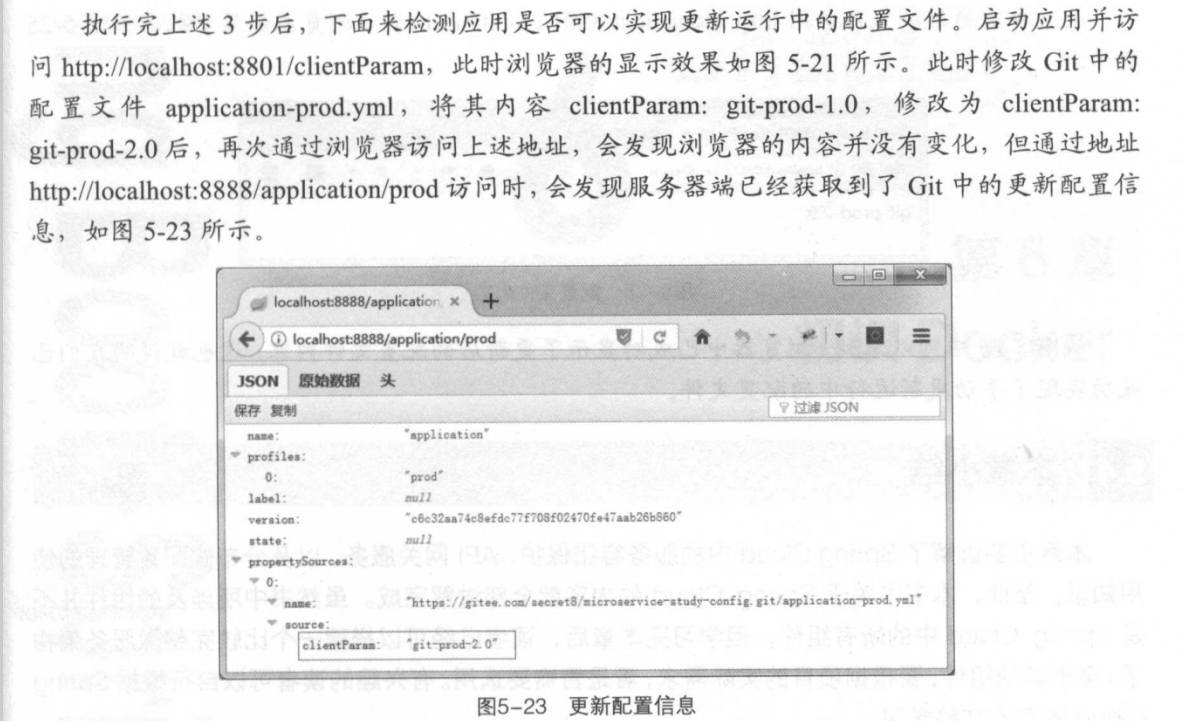
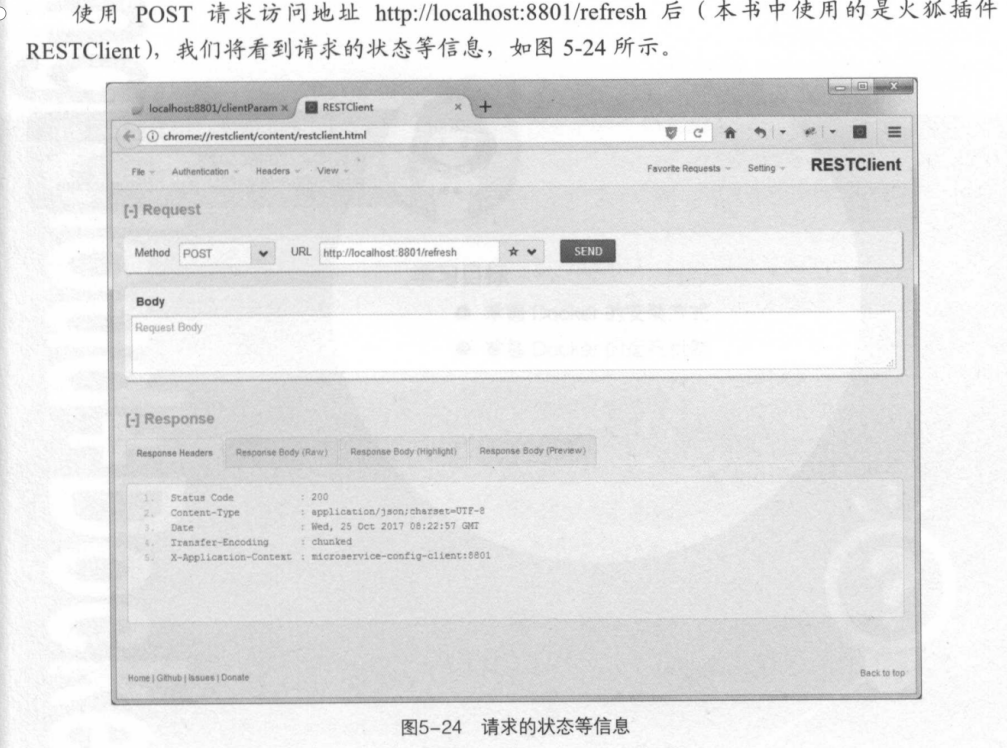
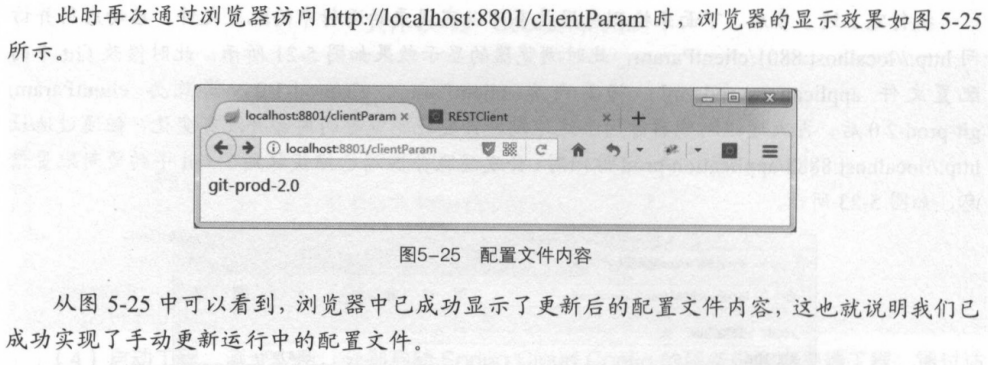




 浙公网安备 33010602011771号
浙公网安备 33010602011771号